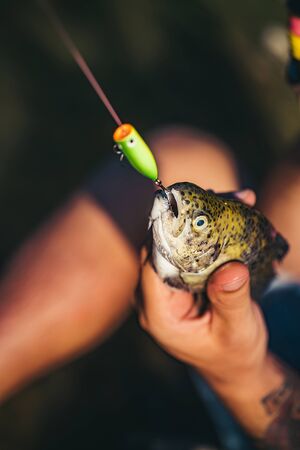1. Inspect and Clean All Your Gear
Before winter sets in, it’s essential to give your fishing tackle a thorough inspection and cleaning. Cold weather can be tough on gear, especially if there’s leftover dirt, salt, or moisture. These elements can cause corrosion, rust, or even damage your equipment if left unchecked.
Why Cleaning Matters
Whether you fish in saltwater or freshwater, your rods, reels, lures, and lines are exposed to the elements. Over time, salt deposits, mud, or plant material can build up, leading to performance issues or long-term damage. A little prep now will save you money and frustration later.
What to Clean and Check
| Gear | What to Look For | Cleaning Tips |
|---|---|---|
| Rods | Cracks in the blank, loose guides, worn-out handles | Wipe down with a damp cloth; use mild soap if needed |
| Reels | Corrosion on metal parts, grinding noises | Rinse with fresh water; dry completely; apply reel oil/grease |
| Tackle Boxes | Dirt buildup, rusted compartments | Empty and wipe clean; air dry before storing |
| Lines | Nicks, frays, memory coils | Replace damaged lines; soak monofilament in warm water to reduce memory |
| Lures & Hooks | Rusty hooks, chipped paint, broken parts | Clean with a toothbrush; replace rusty hooks as needed |
Pro Tip:
If you’ve been fishing in saltwater, make sure you give everything an extra rinse with fresh water. Salt is notorious for causing corrosion during storage.
Storage After Cleaning
Once everything is clean and dry, store your gear in a cool, dry place. Use rod sleeves or cases to protect rods from bending or cracking. Organize tackle boxes so everything stays separated and easy to find when spring rolls around.
2. Properly Store Rods and Reels
Once the temperatures start to drop, it’s time to think about where and how you’re storing your fishing rods and reels. Cold weather can do a number on your gear if you’re not careful. The best way to protect your equipment is to disassemble it and store everything in a dry, temperature-controlled space.
Why Disassembly Matters
Taking apart your rods and reels before storage helps prevent stress on joints and connections. Leaving them assembled can lead to warping or even cracking, especially when exposed to freezing temperatures for long periods. It also gives you a chance to clean each component thoroughly before putting it away.
Ideal Storage Conditions
A damp garage or shed might seem convenient, but moisture and extreme cold can cause rust and other damage. Instead, aim for a spot inside your home—like a closet, basement, or utility room—where the temperature stays relatively stable.
Recommended Storage Environment:
| Condition | Why It Matters |
|---|---|
| Dry | Prevents rust on metal components |
| Temperature-Controlled (50–70°F) | Reduces risk of warping or cracking |
| Away from Direct Sunlight | Protects line and rod finish from UV damage |
Storage Tips for Rods
- Remove the reels: Don’t leave them attached; this helps reduce stress on the reel seat.
- Use rod sleeves: These protect guides and tips from bending or breaking.
- Store vertically or horizontally: Avoid leaning rods in corners where they can warp over time.
Storage Tips for Reels
- Clean and dry thoroughly: Wipe off any moisture or dirt before storage.
- Loosen the drag: This prevents unnecessary tension on internal components.
- Store in padded cases or cloth bags: Keeps dust out and reduces the chance of scratches or dings.
A Quick Checklist Before Storing:
- ✅ Disassemble rods and reels
- ✅ Clean all parts thoroughly
- ✅ Choose a dry, climate-controlled area
- ✅ Use protective sleeves or cases
- ✅ Keep everything organized for easy access next season
Treating your gear with care during the winter months means fewer surprises—and repairs—when spring rolls around. A little prep now goes a long way toward keeping your tackle in top shape.

3. Lubricate Reels and Replace Line
Cold weather can be tough on your fishing gear, especially your reels and fishing line. To keep everything in top shape during the off-season, its a good idea to lubricate your reels and replace any old line before storing your tackle for the winter.
Lubricating Your Reels
Reels have moving parts that can get stiff or even corrode when exposed to cold, moisture, or long periods of storage. Applying reel oil and grease helps keep them smooth and protected. Heres a basic guide:
| Part | Recommended Maintenance |
|---|---|
| Handle knobs | Add a drop of oil to keep them spinning freely |
| Main shaft | Apply light reel grease to prevent rust and sticking |
| Bail arm (spinning reels) | Lubricate hinge points for smooth operation |
| Gears (inside the reel) | Add a small amount of grease for protection during storage |
Replacing Old Fishing Line
Fishing line tends to weaken over time, especially after exposure to sunlight, water, and frequent casting. During winter storage, old line can develop “memory,” which causes it to coil or kink when you use it again. Replacing it now will save you headaches later.
When to Replace Your Line:
- If its frayed or nicked: This makes the line more likely to snap under pressure.
- If its more than a season old: Even if it looks okay, age can weaken the material.
- If youre switching target species: Use the right strength and type of line for different fishing styles.
Types of Line and Lifespan Estimates:
| Line Type | Lifespan |
|---|---|
| Monofilament | 1 season (replace yearly) |
| Braid | Up to 2-3 seasons with care |
| Fluorocarbon | 1-2 seasons depending on usage |
By giving your reels some TLC and swapping out tired line, youll make sure your gear is ready to perform as soon as spring rolls around.
4. Organize and Inventory Tackle
Winter is the perfect time to go through your tackle box and make sure everything is in good shape for spring. Start by laying out all your lures, hooks, sinkers, swivels, and other gear. Take a close look at each item and sort them into categories: keep, clean, repair, or replace.
Check for Damage and Rust
Look closely for rusted hooks, bent lures, or soft plastics that have dried out or melted together. Even small signs of wear can affect how well your bait works in the water. Toss anything that’s too damaged to fix, and clean items with surface rust if they’re still usable.
Make an Inventory List
Once youve sorted through your gear, its a good idea to create a checklist of what you have and what you need to restock. This will save you time and money when spring rolls around and youre ready to hit the water again.
Sample Tackle Inventory Table
| Item | Condition | Action Needed |
|---|---|---|
| Spinnerbaits | Good | None |
| Trebles Hooks | Rusty | Replace |
| Soft Plastics (Worms) | Melted | Discard & Restock |
| Swivels | Slight Wear | Clean & Keep |
Store Everything Properly
After organizing your tackle, be sure to store it in a dry place to prevent further rust or damage. Use tackle trays with adjustable dividers to keep things neat and easy to find later. Labeling each section can also help you stay organized year-round.
5. Consider Cold-Weather Tackle Preparation
If youre planning to fish during the winter months, its important to prep your tackle for the unique challenges that come with cold-weather angling. Freezing temperatures, ice buildup, and sluggish fish behavior all require a shift in your typical gear setup. Heres how you can get your tackle ready for those frosty days on the water.
Use Gear Designed for Winter Conditions
Standard rods and reels might not perform well in freezing temperatures. Ice fishing rods are shorter and built to handle the conditions of fishing through small holes in frozen lakes. Pair them with reels that have anti-freeze lubrication or sealed components to prevent freezing and cracking.
Recommended Winter Fishing Gear
| Gear Type | Winter Recommendation |
|---|---|
| Rod | Ice fishing rod (shorter, more sensitive) |
| Reel | Sealed spinning reel with cold-weather grease |
| Line | Braided or fluorocarbon line (resistant to freezing) |
| Bait | Live bait like waxworms or minnows; glow jigs work well too |
| Tackle Box | Waterproof box with anti-rust dividers |
Select Bait That Works in the Cold
Fish tend to be less active in cold water, so choosing the right bait is key. Live bait like minnows, waxworms, or mealworms often outperforms artificial lures in winter because they offer natural movement and scent. However, some specialized cold-water jigs and spoons are designed to attract bites even when fish are slow-moving.
Create a Dedicated Winter Tackle Setup
If you plan to fish regularly during winter, consider putting together a separate tackle box just for cold-weather use. This helps keep things organized and ensures you’re always ready when opportunity strikes. Include items like hand warmers, ice picks, extra gloves, and a line cutter that works well even when wearing thick gloves.


